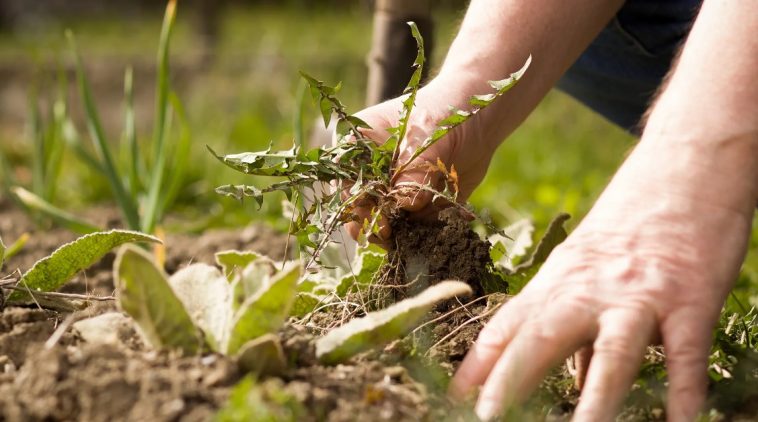Any plant that is not wanted or that sprouts up at the wrong time or in the wrong place is considered as a weed.
There are a number of drawbacks associated with weeds:
- Weeds consume water, nutrients, and sunlight that could otherwise be used by crops.
- Seed contamination is just one way in which weeds can reduce crop quality.
- Several weeds are known to be extremely dangerous.
- Insect pests and diseases can find a new home in weeds.
- It can be pricey to implement weed-control measures.
Weeds have the following positive effects:
- Shelter for beneficial insects and animals can be found in weeds.
- Some weeds can be used as food.
Controlling techniques
Due to the complexity and high cost of chemical weed control, it was decided that it would not be covered in this guide. Before using chemicals to get rid of weeds, it is best to talk to an expert.

It is crucial to eliminate weeds as soon as possible. (Image source: Organic Farm Knowledge)
Ploughing (primary tillage)
There is a chance that ploughing will kill weeds by burying them or by exposing the weeds’ underground portions to dry. On the other hand, ploughing could expose dormant weed seeds to light, which would make it easier for them to grow.
Harrowing/cultivating (secondary tillage)
A harrow or cultivator is used in order to eliminate any potential regrowth after ploughing. Tillage should not go deeper than 10 to 15 cm.
The use of hand tools for weeding
As a general rule, it is best to start weeding as soon as possible so that your crops do not have to compete with unwanted vegetation. Maize, cotton, groundnuts, beans, and sweet potatoes all benefit greatly from a weed-free environment early in their development.

Harrowing weeds with an implement and tractor. (Image source: britannica.com)
For the most part, weeds are eliminated in the course of the season by either having them pulled out or being cut with a hoe. Weeds are uprooted and then left on the soil to act as a mulch and increase the soil’s organic matter content. It is not uncommon to thin the crop and fill in the gaps at the same time as weeding. Although the cost of the tools used in hand hoeing is low, the amount of work required is high. Most of the time, a farmer’s ability to farm a certain piece of land is limited by the need to take care of weeds during the growing season.
Most people suggest using secondary tillage tools like harrows and cultivators to get rid of weeds mechanically. A tine harrow is ideal for this task.
However, crops can be mechanically weeded only in a grid pattern, so that some weeds may be skipped.
If tractors are used, the price of implements can skyrocket. Cheap cultivators pulled by donkeys or oxen are easy to find in Namibia. When used with row planting, these cultivators are an effective way for small farmers to get rid of weeds at a price they can afford. This means that more land can be used for farming.

The tiller plough is used to prepare a seedbed and get rid of weeds by machine. (Image source: Pixabay)
Animal-drawn cultivators require furrows to be 80 to 90 cm wide. In order to create narrower furrows, you will need well-trained animals and skilled operators. On-farm trials indicate that using a cultivator drawn by a donkey can significantly outpace hoeing for weeding. When using a cultivator drawn by an ox, weeding can be accomplished twenty times quicker than when using a hoe. Hand hoe weeding is still necessary to get rid of weeds in the gaps between crop rows.
Specific crops and vegetables
Every corner of the globe, including Namibia, is used to cultivate an enormous variety of crops. Plants like the prickly pear are included, as well as vegetables and herbs, citrus, olives, grapes, subtropical fruit, cereal grains, and fodder plants like lucerne and old man salt bush.
It would be impossible to write a book that covers every conceivable type of crop and every possible variety of cultivars. However, it should be noted that for most crops, a number of cultivars are commercially available and that the selection of a specific cultivar can “make or break” the success of the business.
A farmer needs to accept the fact that there is no magic bullet cultivar that can withstand all possible climate, soil, water, disease, and pest threats.

Weeds are clearly visible between the crop rows. (Image source: scientificamerican.com)
Therefore, one should choose the best option from the available range, or perhaps even try a few different cultivars, and then identify the best-producing ones over a number of seasons. Consider the following factor before purchasing seed:
The purpose for which the crop is planted. For instance, home consumption would require a long-season cultivar, but when selling the produce, it could be more desirable to have enough available at the earliest possible markets.
The information in this article is credited to the Namibia Agricultural Union and Namibia National Farmers Union who published the Crop Production Manual in 2008.









